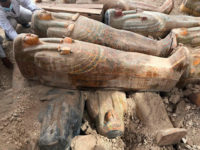 A cache of 30 exquisitely painted wood coffins have been unearthed at the ancient necropolis of Asasif on the west bank of the Nile in Luxor. The sarcophagi were found one meter (3.2 feet) under the surface. They had been carefully stacked in two rows and are in excellent condition, the colors vivid, the lids still sealed and the contents well-preserved.
A cache of 30 exquisitely painted wood coffins have been unearthed at the ancient necropolis of Asasif on the west bank of the Nile in Luxor. The sarcophagi were found one meter (3.2 feet) under the surface. They had been carefully stacked in two rows and are in excellent condition, the colors vivid, the lids still sealed and the contents well-preserved.
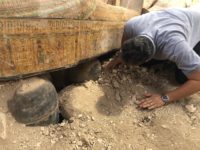 Asasif necropolis, located in the ancient site of West Thebes, includes tombs dating back to the Middle, New Kingdom and the Late Periods (1994 B.C. to 332 B.C.). This was not a tomb, however. This is a cachette of coffins, meaning the group was deliberately hidden (cacher means “to hide” in French) to deter grave robbers. It is only the fourth large cachette ever discovered, and the previous three were found over a century ago. They were buried in the mountain beneath a cliff in Deir al-Bahari, not in a tomb, and obviously it was an excellent choice of location because the sarcophagi were never looted and the dry environment has kept them pristine.
Asasif necropolis, located in the ancient site of West Thebes, includes tombs dating back to the Middle, New Kingdom and the Late Periods (1994 B.C. to 332 B.C.). This was not a tomb, however. This is a cachette of coffins, meaning the group was deliberately hidden (cacher means “to hide” in French) to deter grave robbers. It is only the fourth large cachette ever discovered, and the previous three were found over a century ago. They were buried in the mountain beneath a cliff in Deir al-Bahari, not in a tomb, and obviously it was an excellent choice of location because the sarcophagi were never looted and the dry environment has kept them pristine.
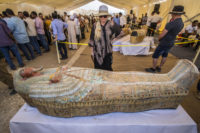 The coffins are believed to date to the 22nd Dynasty, some 3,000 years ago, and belonged to a single family of important priests to the gods Amun and Khonsu, the chief deities of Thebes (modern-day Luxor). There are men, women and children, each individually mummified, wrapped and placed in elaborately carved and painted coffins. The
The coffins are believed to date to the 22nd Dynasty, some 3,000 years ago, and belonged to a single family of important priests to the gods Amun and Khonsu, the chief deities of Thebes (modern-day Luxor). There are men, women and children, each individually mummified, wrapped and placed in elaborately carved and painted coffins. The 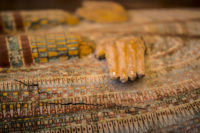 sarcophagi are richly decorated with hieroglyphics, figures of people and deities, birds, snakes, lotus flowers in vivid white, yellow, red, green, blue and black. There are scenes from the Book of the Dead, offerings to pharaohs and inscriptions identifying the deceased including one named individual who was a singer to the god Amun.
sarcophagi are richly decorated with hieroglyphics, figures of people and deities, birds, snakes, lotus flowers in vivid white, yellow, red, green, blue and black. There are scenes from the Book of the Dead, offerings to pharaohs and inscriptions identifying the deceased including one named individual who was a singer to the god Amun.
“It is the first large human coffin cache ever discovered since the end of the 19th century,” the Egyptian antiquities minister, Khaled El-Enany, was quoted as saying during a ceremony in Luxor.
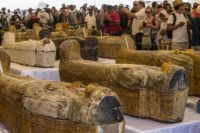 It’s also the first sarcophagus cache ever unearthed by a team of Egyptian archaeologists. The other large chachette finds — one discovered Deir al-Bahari in 1881, one in the tomb of King Amenhotep II “KV35” in 1898 and one at Bab al-Gusus in 1891 — were made by foreign missions.
It’s also the first sarcophagus cache ever unearthed by a team of Egyptian archaeologists. The other large chachette finds — one discovered Deir al-Bahari in 1881, one in the tomb of King Amenhotep II “KV35” in 1898 and one at Bab al-Gusus in 1891 — were made by foreign missions.
The sarcophagi will be transferred to the Grand Egyptian Museum, the new museum near the pyramids of Giza scheduled to open next year.
They appear to be made of fiberglass or papier-mâché.
Are these coffins expected to contain items that would have made them worthwhile to grave robbers thousands of years ago?
Mummy wrappings often contain a series of amulets as part of the process. These sometimes are or precious materials. Jewelry is often included.